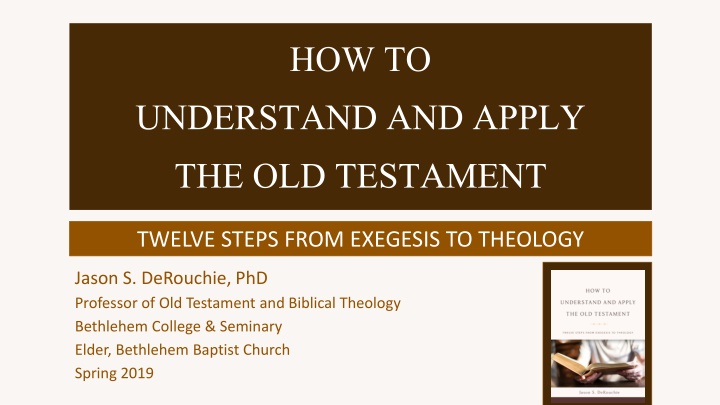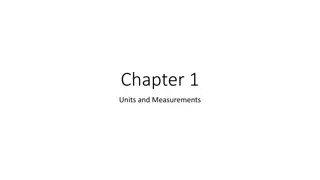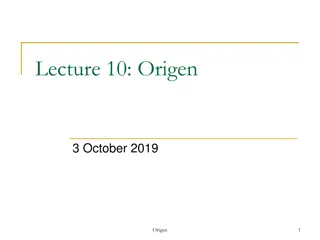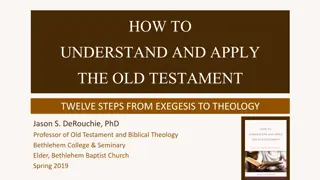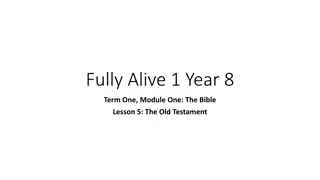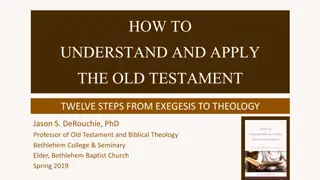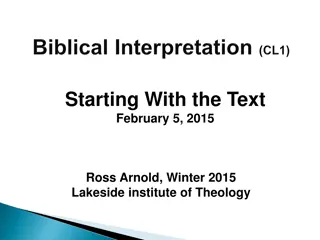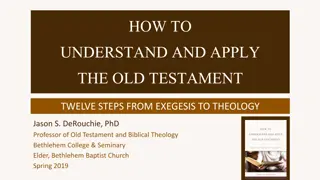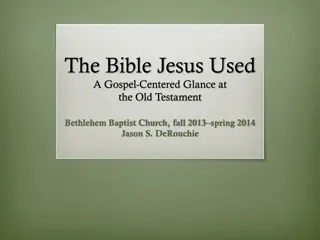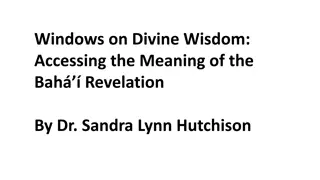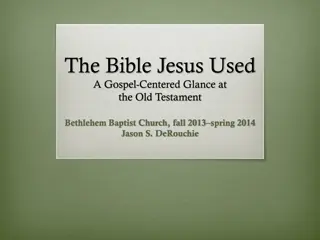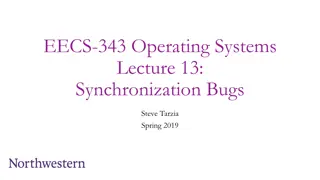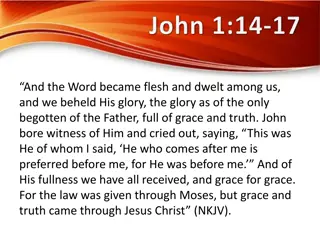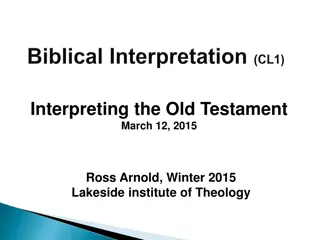Old Testament Exegesis: Literary Units and Structure Analysis
Discover the ancient wisdom of the Old Testament through a structured approach. Learn how to establish literary units, decipher boundaries, and unravel the basic structures of biblical passages. Gain insights from key questions, examples from Genesis and Psalms, and understanding the evolution of multivolume works. Dive deep into the richness of the Old Testament narrative for theological exploration and application.
Download Presentation

Please find below an Image/Link to download the presentation.
The content on the website is provided AS IS for your information and personal use only. It may not be sold, licensed, or shared on other websites without obtaining consent from the author.If you encounter any issues during the download, it is possible that the publisher has removed the file from their server.
You are allowed to download the files provided on this website for personal or commercial use, subject to the condition that they are used lawfully. All files are the property of their respective owners.
The content on the website is provided AS IS for your information and personal use only. It may not be sold, licensed, or shared on other websites without obtaining consent from the author.
E N D
Presentation Transcript
HOW TO UNDERSTAND AND APPLY THE OLD TESTAMENT TWELVE STEPS FROM EXEGESIS TO THEOLOGY Jason S. DeRouchie, PhD Professor of Old Testament and Biblical Theology Bethlehem College & Seminary Elder, Bethlehem Baptist Church Spring 2019
2. LITERARY UNITS AND TEXT HIERARCHY Goal: Determine the limits and basic structure of the passage. Key Questions Basic Rule for Establishing Literary Units
Key Questions Is there a clear beginning and end to your passage? Are there clues in the content, the grammar, or both that clarify a passage s boundaries and basic structure?
Basic Rules for Establishing Literary Units Don t automatically follow an English translation s verse and chapter divisions. Facts: o Jewish scribes probably began to separate verses during the age of the Talmud (ca. AD 135 500), but the numbering of verses did not occur until the 16th century. o Only in the 1,200s did Roman Catholic Stephen Langton (AD 1150 1228) add the chapter divisions.
Example 1: Genesis 1:12:3 Example 2: Psalms 1 2 o Links: Neither psalms has a title Framed by blessed formula (1:1; 2:12) Catchwords: blessed (1:1; 2:12); way (1:1, 6; 2:12); sit (1:1; 2:4); meditate/plot (1:2; 2:1); perish (1:6; 2:12) o 6th century Greek Codex D (a New Testament Greek manuscript) introduces Paul s citation of Psalm 2:7 in Acts 13:33 with as also it is written in the first psalm.
Remember that some multivolume works in our English Bible were single books in Jesus s Bible. Group 1: When the Jews took the original that had only consonants and expanded it into Greek, they added vowels, thus doubling the size of books and making some too big to fit on single scrolls. o Examples: 1 2 Samuel (Samuel); 1 2 Kings (Kings), 1 2 Chronicles (Chronicles); contrast 1 2 Corinthians, 1 2 Timothy, 1 2 Peter, 1 2 John
o The Greek OT (Septuagint) treats 12 Samuel and 12 Kings as one long Book of the Kings of Israel and Judah = 1 4 Kingdoms. One long story from the monarchies beginning to end with artificial divisions at each seam: The natural sequel to Saul s death is David s lament, which appears in 2 Samuel. 2 Samuel is devoted entirely to Samuel, but his death and transfer of power to Solomon are delayed to 1 Kings. 1 2 Kings divides in the middle of the Elijah narratives.
o The Greek OT (Septuagint) treats 12 Samuel and 12 Kings as one long Book of the Kings of Israel and Judah = 1 4 Kingdoms. One long story from the monarchies beginning to end with artificial divisions at each seam: Comparable word counts: 1 Samuel (19,007 words) from Samuel s birth to Saul s death. 2 Samuel (15,801 words) from Saul s death to the end of David s reign. 1 Kings (18,635 words) from Solomon s rise to Ahab s death. 2 Kings (17,348 words) from Ahaziah to the fall of Jerusalem in 586 BC.
Group 2: Other books that we sometimes view as two that the Jews do not. o Ezra-Nehemiah o The Book of the Twelve Minor Prophets Acts 7:42. But God turned away and gave them over to worship the host of heaven, as it is written in the book of the prophets (citing Amos 5:25 27).
Look for recognizable beginning and ending markers. What clues do we give in English communication? Samples of similar clues in Scripture: o Beginning markers: Title(e.g., A prayer of Habakkuk the prophet, according to the Shegionoth, Hab 3:1) Introductory formula (e.g., These are the generations of , Gen 2:4; 5:1; 6:9; etc.; And the people of Israel did what was evil in the sight of the LORD, Judg 3:7, 12; 4:1; etc.) Common beginning words or phrases (e.g., Thus says the LORD, Amos 1:3; Hear!, Deut 5:1; 6:4; 9:1; Woe! Zeph 2:5; 3:1; And now, Deut 4:1; 10:12; Behold! Zeph 3:19)
Vocative address (e.g., O LORD, Ps 8:1; Hear, O Israel, Deut 5:1) Rhetorical questions (e.g., Why do the nations rage and the peoples plot in vain? Ps 2:1) Shifts in time (e.g., When Abraham was ninety-nine years old, Gen 17:1) Shifts in place (e.g., And the people of Israel ... came into the wilderness of Zin, Zum 20:1) Shifts in characters or speakers (e.g., The Eliphaz the Temanite answered and said, Job 4:1)
Shifts in topic or theme (e.g., Comfort, comfort my people, says your God, Isa 40:1) Shifts in genre (e.g., from narrative to genealogy in Gen 11:10) Shifts from poetry to prose or vice versa (e.g., In the fourteenth year of King Hezekiah in Isa 36:1 after the poetry of Isa 35)
o Ending markers: Concluding formulae (e.g., And there was evening and there was morning, Gen 1:5, 8, 19, etc.) Poetic refrains(e.g., Yet you did not return to me, Amos 4:6, 8, 9, etc.) Summary statements(e.g., This is the law of the burnt offering, of the grant offering, of the sin offering , which the LORD commanded Moses, Lev 7:37 38) Conclusions(e.g., And the LORD gave them rest on every side, Josh 21:43)
Treat literary units as wholes. Look for patterns of similarity. o Similar time period (e.g., the time before the fall, Gen 2:4 25) o Similar location (e.g., Israel at Mount Sinai, Exod 19:1 Num 10:10) o Similar characters (e.g., the judgeship of Samson, Judg 13:1 16:31) o Similar topics or themes (e.g., the tabernacle-building instructions, Exod 25:1 31:18) o Similar poetic devices (e.g., the alphabetic acrostic in Psalm 119 or Prov 31:10 31) o Similar genre (e.g., the song at the sea in Exod 15:1 18)
Specific rules for different genres. o Historical narrative: Deal with scenes in light of whole episodes. E.g., Gen 39: A charge to flee temptation? The unit boundaries: The LORD was with Joseph (4x) The LORD was with Joseph when he entered Egypt as a slave (39:2). The LORD was with him when he served Potiphar s house (39:3). But the LORD was with Joseph when Potiphar s wife unjustly accused him of sexual misconduct and had him thrown into prison (39:21). The LORD was with him during his extended incarceration (39:23).
Specific rules for different genres. o Historical narrative: Deal with scenes in light of whole episodes. E.g., Gen 39: A charge to flee temptation? The unit boundaries: The LORD was with Joseph (4x) Significance: The repetition helps frame the limits of the episode. The repetition highlights that his is less a passage about Joseph or sexual purity and more about God. The LORD remains with those who consider pleasing him to be a greater prize than pleasing worldly passions.
o Prophetic sermons: Deal with paragraphs in light of whole oracles. Ask, what is the function of my passage? Does my paragraph contribute to the primary exhortation? Or is it part of the motivation, whether through historical reflection, promise, or prediction? E.g., Deut 5: The Ten Commandments? Directive to heed Moses s voice (5:1) History Lesson about Moses s being set apart as mediator (5:2 31) Directive to heed Yahweh s voice (through Moses) (5:32 33)
o Poetry in the Psalms: Deal with stanzas (poetic paragraphs) in light of whole psalms. E.g., ESV of Pss 1 2 Psalm 1: Stanza 1 (vv. 1 2) Stanza 2 (vv. 3 4) Stanza 3 (vv. 5 6) Psalm 2: Stanza 1 (vv. 1 3) Stanza 2 (vv. 4 6) Stanza 3 (vv. 7 9) Stanza 4 (vv. 10 12)
Check your decision against modern translations and, if possible, the standard Hebrew text. ESV of Psalm 1 NASB of Psalm 1 CSB of Psalm 1 1:1 Blessed is the man 1:2 but his delight 1:1 How blessed is the man 1:2 But his delight 1:3 He will be like a tree 1:1 How happy is the one 1:2 Instead, his delight 1:3 He is like a tree 1:4 The wicked are not so 1:5 Therefore the wicked 1:6 For the LORD knows 1:4 The wicked are not 1:5 Therefore the wicked 1:3 He is like a tree 1:4 The wicked are no so 1:5 Therefore the wicked 1:6 for the LORD knows 1:6 For the LORD watches
